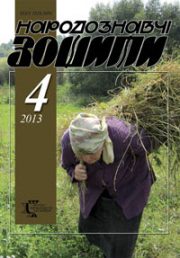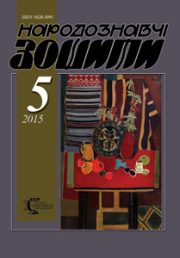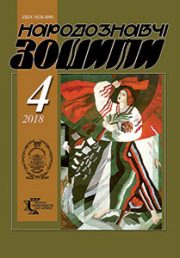The Ethnology Notebooks. 2018, 6 (144), 1578–1588
UDK 930:[746(=161.2)»16/18»:27-525.7-526.7]:7.04:27-31
DOI https://doi.org/10.15407/nz2018.06.1578
Received 21.11.2018
UKRAINIAN ONE-FIGURE EMBROIDERED SHROUDS: ORIGIN AND ICONOGRAPHIC FEATURES
ORCID ID: https://orcid.org/0000-0002-7292-3264
Oliinyk Olha, Candidate of Sciences in Art Studies, research fellow
Folk Art Department,
at the Institute of Ethnology of the National Academy of Sciences of Ukraine,
15 Svobody Avenue, 79000, Lviv, Ukraine.
Contacts: e-mail: oliao-m@i.ua
Abstract. The Ukrainian one-figured embroidered shrouds, which dominated almost until the beginning of the XIX-th century, represent the so-called syndonic type of iconography. On the example of the few preserved Ukrainian monuments of the seventeenth and mid-nineteenth centuries and analogies investigated the formation of the main type and iconographic differences in the works of the leading monastic centers of church sewing. Ukrainian embroidered shrouds with the iconographic plot «Christ in the Tomb» appear as a distinctive phenomenon in sacred art.
Keywords: shroud, iconography, embroidered, Christ in the tomb, Sindon, attributes of passions.
REFERENCES
NKPIKZ, KPL-T-423.
NKPIKZ, KPL-T-441.
NKPIKZ, KPL- T-851.
NKPIKZ, KPL-T-823.
NKPIKZ, KPL-T-439.
ChOIM, ChIM-1553.
DIM, K-327.
NKPIKZ, KPL-T-909.
NKPIKZ, KPL-T-854.
NKPIKZ, KPL-T-5152.
NKPIKZ, KPL-T-859.
NKPIKZ, KPL-T-853.
NKPIKZ, KPL-T-866.
Redyna, E.K. (Ed.). (1903). Al’bom vystavky ХII Arkheolohycheskoho s’ezda v h. Khar’kove. Moskva [in Russian].
Varyvoda, A. (2006). Haptovani plaschanytsi v kolektsii Natsional’noho Kyievo-Pechers’koho zapovidnyka. Lavrs’kyj al’manakh: Zbirnyk naukovykh prats’, 16, 138—142. Kyiv: Natsionalnyi Kyievo-Pecherskyi istoryko-kulturnyi zapovidnyk [in Ukrainian].
Varyvoda, A. (2015). Pam’iatky ukrains’koho tserkovnoho haptuvannia ХVII—ХVIII st. z kolektsii Natsional’noho Kyievo-Pechers’koho istoryko-kul’turnoho zapovidnyka iak ob’iekt kul’turnoi spadschyny (dys. … kand. istor. nauk : 26.00.05). Kyiv [in Ukrainian].
Drozdova, O. (2005). Ykonohrafyia Oplakyvanyia y Pohrebenyia Hospoda y Boha y Spasa nasheho Yysusa Khrysta v lytsevom shyt’e. Ubrus. Tserkovnoe shyt’e. Ystoryia y sovremennost, 3, 3—36. Sankt-Peterburh: Yzdanye Zolotoshvejnoj masterskoj pry Uspenskom podvor’e Optynskoj pustyny [in Russian].
Kara-Vasyl’ieva, T. (2008). Istoriia ukrains’koi vyshyvky. Kyiv: Mystetstvo [in Ukrainian].
Kara-Vasyl’ieva, T. (1996). Liturhijne shytvo Ukrainy ХVII—ХVIII st. Ikonohrafiia, typolohiia, stylistyka. L’viv: Svichado [in Ukrainian].
Kara-Vasyl’ieva, T. (2001). Ukrains’ka plaschanytsia: istoriia, ikonohrafiia i symvolika. Kyivs’ka tserkva. 2-3, 193—198. Kyiv-L’viv: Vyd. oo. Vasylyian [in Ukrainian].
Katasonova, E. (2007). Materialy k ykonohrafyy pokrovtsov v lytsevom shyt’e. (Chast’ 2). Ubrus. Tserkovnoe shyt’e. Ystoryia y sovremennost’, 8, 3—41. Sankt-Peterburh: Yzdanie Zolotoshvejnoj masterskoj pry Uspenskom podvor’e Optynskoj pustyny [in Russian].
Kondakov, N. (1902). Pamiatnyky khrystianskoho yskusstva na Afone. Sankt-Peterburh [in Russian].
Kosiv, R. (2015). Mal’ovani plaschanytsi ХVII t. iz zakhidnoukrains’kykh khramiv: ikonohrafiia i stylistyka. Visnyk Kharkivs’koi derzhavnoi akademii dyzajnu i mystetstv: Zb. nauk. pr. 7, 112—118 [in Ukrainian].
Myrkovych, L. (2004). Yskusstvo tserkovnoho shyt’ia (II. Plaschanytsy). Ubrus. Tserkovnoe shyt’e. Ystoryia y sovremennost’, 2, 31—44. Sankt-Peterburh: Yzdanie Zolotoshvejnoj masterskoj pry Uspenskom podvor’e Optynskoj pustyny [in Russian].
Opysanye sviatyn’ Konstantynopolia v latynskoj rukopysy XII veka (Perevod, predyslovye y kommentaryj L. K. Masyelia Sanchesa). (1996). In Chudotvornaia ykona v Vyzantyy y Drevnej Rusy. Moskva: Маrtys [in Russian].
Putsko, V. (2005). Vyzantyjskie plaschanytsy: varianty kompozytsyonnoj skhemy. Ubrus. Tserkovnoe shyt’e. Ystoryia y sovremennost’, 3, 37—48. Sankt-Peterburh: Yzdanie Zolotoshvejnoj masterskoj pry Uspenskom podvor’e Optynskoj pustyny [in Russian].
Putsko, V. (1992). Ukrains’ki plaschanytsi. Liudyna i svit, 7—8, 41—44 [in Ukrainian].
Rober de Klary. (1986). Zavoevanie Konstantynopolia [La conquete de Constantinople]. (Per. y komm. M.A.Zaborova). Moskva: Nauka [in Russian].
Sokrovyscha Sviatoj Hory. (1997). Kataloh vystavky. Salonyky [in Russian].
Moisescu C., Musicescu M., & Sirli A. (1982). Putna. Bucuresti.
Shalyna Yryna Aleksandrovna. Ykona “Khrystos vo hrobe” y Nerukotvornyj Obraz na Konstantynopol’skoj plaschanytse (Yz materialov konferentsyy “Nauchnie y bohoslovskie aspekty yssledovanyia Turynskoj Plaschanytsy y chudesnykh znamenyj, proyskhodiaschykh v Pravoslavnoj Tserkvy”). Retrieved from: http://vvv.pravoslavie.ru/sretmon/turin/hristosvogrobe.htm.
Sviato-Trekhsviatytel’skyj khram, h. Dnepr. Retrieved from: http://trisviat-dp.church.ua/.
U Natsional’nomu muzei istorii Ukrainy vidkrylas’ vystavka «Svitle Voskresinnia Khrystove». Retrieved from: http://risu.org.ua/ua/indekh/all_nevs/tsulture/satsral_art/59661/.
Ryzhova O.O. Opyt restavratsyy zhyvopysnykh vstavok v pamiatnykakh shyt’ia ХVIII—ХIХ vv. Retrieved from: http://art-tson.ru/node/932.







